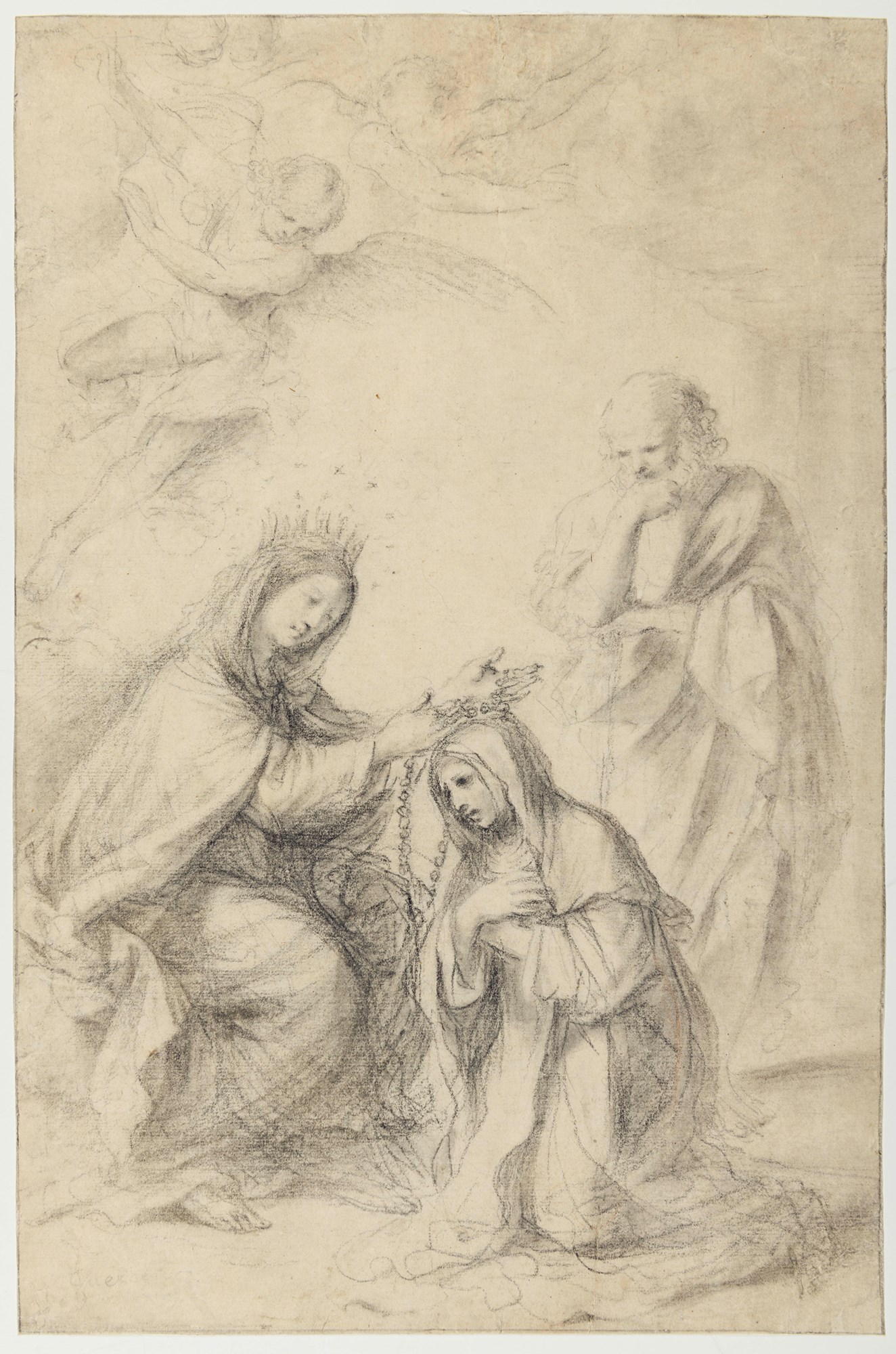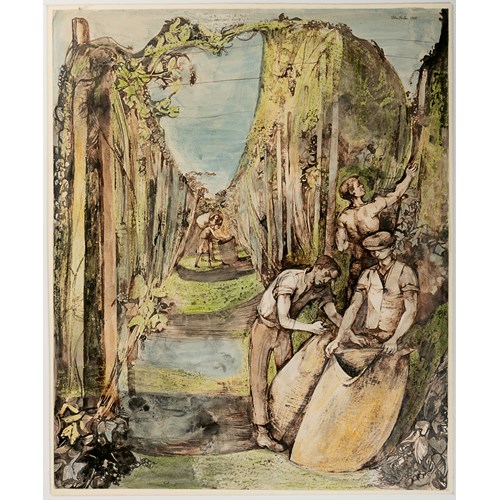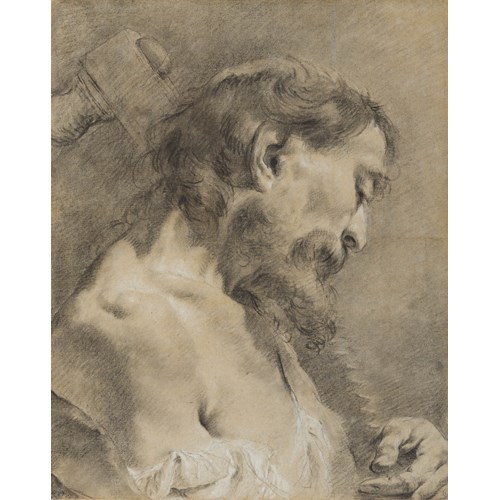Marketplace
Saint Teresa Receiving a Necklace from the Virgin, with Saint Joseph Behind
Giovanni Francesco Barbieri GUERCINO
Saint Teresa Receiving a Necklace from the Virgin, with Saint Joseph Behind
The 16th century Spanish Carmelite nun and mystic Saint Teresa of Ávila was canonized in 1622, during the brief papacy of Pope Gregory XV Ludovisi, at a time when Guercino was working in Rome in the service of the Bolognese Pope and his family. The artist is likely to have been familiar with the saint’s life and writings, and included the figure of Saint Teresa in a number of his paintings.
This fine compositional drawing in matita nera is a study for Guercino’s late altarpiece of The Vision of Saint Teresa of Ávila (or Saint Teresa Receiving a Necklace from the Virgin in the Presence of Saint Joseph), painted for the convent church of San Gabriele delle Monache Carmelitane Scalze in Bologna. Guercino began working on the painting in 1660 and received payment of 800 Bolognese lire for the altarpiece on 21 March 1661. The painting remained in the church of San Gabriele until 1811, when it was transferred to the Pinacoteca di Brera in Milan. Exhibited there between 1811 and 1965, the painting has since been returned on loan to the Carmelite convent in Bologna.
The scholar and curator Jacob Bean once noted that ‘When Guercino took pen in hand and jotted down alternative solutions to a compositional problem, he was almost invariably bursting with ideas. Often a series of preparatory drawings for a picture proposes figure groupings so radically different that only certain fixed iconographical features of the subject and a stylistic unity identify the drawings as preparatory for the same picture.’
Two further compositional studies for the 1661 altarpiece of The Vision of Saint Teresa of Ávila, both with significant differences to the final painting, were formerly in the collection of Sir Denis Mahon and are now in the Ashmolean Museum in Oxford; one is a rapid study in pen and wash and the other a more highly finished drawing in two shades of red chalk. A third compositional drawing, executed in pen and wash, appeared at auction in London in 1983 and is now in a private collection. This last drawing is somewhat closer to the present sheet than the two Ashmolean sheets, particularly in the poses of both the Virgin and Saint Theresa, as well as the prominent angel just above them.
Finally, two drapery studies in red chalk for the altarpiece are part of the large group of such drawings by Guercino today in the Koenig-Fachsenfeld collection at the Staatsgalerie in Stuttgart. These are a highly finished drawing for the mantle of the seated Virgin and a double-sided sheet which contains studies for the drapery of both the Virgin and Saint Joseph.
This fine compositional drawing in matita nera is a study for Guercino’s late altarpiece of The Vision of Saint Teresa of Ávila (or Saint Teresa Receiving a Necklace from the Virgin in the Presence of Saint Joseph), painted for the convent church of San Gabriele delle Monache Carmelitane Scalze in Bologna. Guercino began working on the painting in 1660 and received payment of 800 Bolognese lire for the altarpiece on 21 March 1661. The painting remained in the church of San Gabriele until 1811, when it was transferred to the Pinacoteca di Brera in Milan. Exhibited there between 1811 and 1965, the painting has since been returned on loan to the Carmelite convent in Bologna.
The scholar and curator Jacob Bean once noted that ‘When Guercino took pen in hand and jotted down alternative solutions to a compositional problem, he was almost invariably bursting with ideas. Often a series of preparatory drawings for a picture proposes figure groupings so radically different that only certain fixed iconographical features of the subject and a stylistic unity identify the drawings as preparatory for the same picture.’
Two further compositional studies for the 1661 altarpiece of The Vision of Saint Teresa of Ávila, both with significant differences to the final painting, were formerly in the collection of Sir Denis Mahon and are now in the Ashmolean Museum in Oxford; one is a rapid study in pen and wash and the other a more highly finished drawing in two shades of red chalk. A third compositional drawing, executed in pen and wash, appeared at auction in London in 1983 and is now in a private collection. This last drawing is somewhat closer to the present sheet than the two Ashmolean sheets, particularly in the poses of both the Virgin and Saint Theresa, as well as the prominent angel just above them.
Finally, two drapery studies in red chalk for the altarpiece are part of the large group of such drawings by Guercino today in the Koenig-Fachsenfeld collection at the Staatsgalerie in Stuttgart. These are a highly finished drawing for the mantle of the seated Virgin and a double-sided sheet which contains studies for the drapery of both the Virgin and Saint Joseph.
Provenance: Anonymous sale, Paris, Christie’s, 16 April 2008, lot 21
Gérard Lhéritier (Aristophil), Nice.
Literature: Nicholas Turner, The Paintings of Guercino: A Revised and Expanded Catalogue raisonné, Rome, 2017, p.761, under no.486.
More artworks from the Gallery









_T638545819346538474.jpg?width=500&height=500&mode=pad&scale=both&qlt=90&format=jpg)